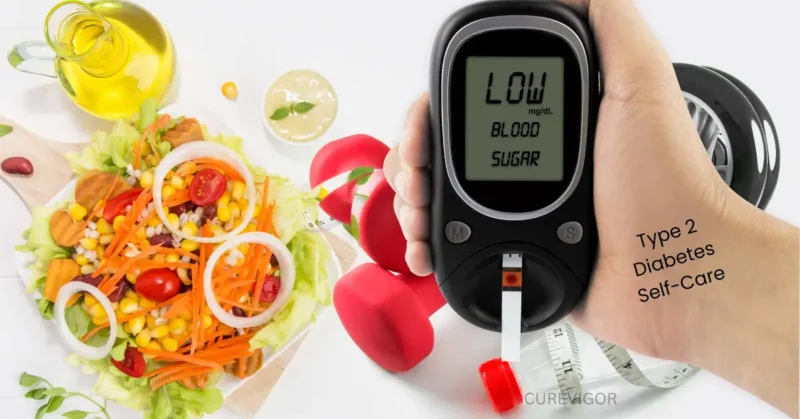Simple type 2 diabetes self-care routines for steady energy, balanced blood sugar, and long-term health you can maintain every day.
Thank you for reading this post, don't forget to subscribe!Living with type 2 diabetes takes more than just controlling your blood sugar—it’s about developing a lifestyle that fuels your body, sharpens your intellect, and safeguards your future.
Managing diabetes may sound overwhelming at first, but the truth is that small, consistent habits have the power to transform your health.
Managing Type 2 Diabetes with Self-Care: Practical Steps for Wellness
Think of self-care as a toolkit. Inside are routines you can reach for daily—what you eat, how you move, the way you rest, and even how you handle stress. Each choice, even a simple one like swapping soda for water or taking a 10-minute walk, adds up to better energy, fewer complications, and a stronger foundation for long-term health.
The good news? You don’t need a complete life overhaul. Instead, you build steady, manageable routines that fit into your current lifestyle. Over time, these routines become second nature, and that’s when real progress begins to happen.

Understanding Type 2 Diabetes Self-Care
Self-care with type 2 diabetes is more than following instructions from your doctor—it’s about becoming the CEO of your own health. You take charge, and your healthcare team becomes your support system. When you view it this way, self-care stops feeling like a burden and begins to feel like a form of empowerment.
Here are the key pieces of effective self-care:
- A balanced diet, regular exercise, effective stress management, and prioritising sufficient sleep are examples of lifestyle modifications. They’re the daily practices that keep blood sugar in check and improve overall wellness.
- Medication adherence: If your doctor prescribes medication or insulin, sticking to the schedule is vital. Missing doses can throw off your progress, while consistency helps your body function smoothly.
- Regular monitoring: Checking your blood sugar, blood pressure, and other health markers gives you immediate feedback. It’s like having a dashboard that shows how your choices—meals, workouts, or even stress—impact your body in real time.
When you take ownership of these areas, the benefits ripple out beyond diabetes control. You’ll often find you have more energy, more precise focus, steadier moods, and a sense of confidence that comes from knowing you’re steering your own health journey.
Self-care isn’t about perfection—it’s about paying attention, making minor adjustments, and celebrating progress along the way.
Type 2 Diabetes Self-Care: Simple Routines for Energy and Long-Term Health
Healthy Eating
Nutrition is at the heart of self-care for type 2 diabetes. What you put on your plate directly affects your blood sugar levels, energy levels, and long-term health. Instead of thinking of “dieting,” think of fueling your body wisely.
- Vegetables and fruits: Non-starchy vegetables, such as spinach, broccoli, zucchini, and peppers, are low in carbs and high in fiber, which slows down the rate at which your body absorbs sugar. Pair them with colorful fruits like berries, apples, or pears—these provide vitamins and antioxidants without spiking blood sugar as quickly as tropical fruits like mangoes or pineapple/
- Whole grains: Skip white bread, pasta, and rice, which act like sugar in the body. Instead, swap in oats, quinoa, barley, or brown rice. These grains release energy gradually, keeping you fuller longer and reducing sugar crashes.
- Lean proteins: Protein helps balance meals and keeps cravings in check. Good choices include skinless chicken, turkey, lentils, beans, and omega-3-rich fish (such as salmon or sardines).
- Healthy fats: Don’t fear fat—it’s vital for brain function, hormone balance, and satiety. Avocados, walnuts, flaxseeds, and olive oil can help protect your heart and aid in the absorption of fat-soluble vitamins.
Real-life tip: Instead of cutting out foods you love, look for smart swaps. For example, replace chips with roasted chickpeas for a crunchy alternative, or soda with sparkling water and lime for a refreshing treat.
Pro strategy: Try using the plate technique, which involves dividing your meal into half non-starchy vegetables, 25% lean protein, and 25% whole grains or starchy vegetables. This visual guide helps maintain balanced portions without requiring calorie counting.
Regular Exercise for Type 2 Diabetes Self-Care
Exercise isn’t just about burning calories—it’s medicine for your body. Physical activity helps your muscles absorb sugar from the blood, improves insulin sensitivity, and boosts circulation, which is especially important for protecting nerves and heart health.
- Start with what you enjoy: If you dread the gym, don’t go. Instead, try brisk walks in the park, swimming at a local pool, dancing to your favorite playlist, or gardening. Movement is movement, and consistency matters more than perfection.
- The 150-minute rule: Aim for 30 minutes of moderate activity, five days a week. Break it into smaller chunks if needed—three 10-minute walks after meals can be just as effective as one 30-minute session.
- Strength training: Twice a week, add light weights, resistance bands, or even bodyweight exercises like squats and push-ups. Building muscle helps your body process glucose more efficiently.
- Everyday movement counts: Take the stairs, park farther from the store, or stand up and stretch during long periods of sitting. These micro-choices add up.
Energy booster tip: A 10–15 minute walk after meals is one of the simplest, most effective ways to lower blood sugar spikes and prevent post-meal sluggishness.
Stress Management
Stress doesn’t just weigh on your mind—it physically raises blood sugar by releasing hormones like cortisol and adrenaline. That’s why stress management isn’t optional; it’s part of diabetes management.
- Quick resets: Take a breath through your nose for four seconds, hold it for seven seconds, and then release it through your mouth for eight seconds. This is known as the “4-7-8” breathing technique. This slows the heart rate and calms the nervous system in minutes
- Mind-body exercises that integrate movement and mindfulness, such as yoga, tai chi, and meditation, can help individuals feel less anxious while also improving their flexibility and balance.
- Creative outlets, such as journaling, sketching, cooking, or even singing, can be powerful stress relievers. These activities shift your focus away from stress triggers and toward something joyful.
- Connection: Stress hormones can be lowered and emotional resilience increased by spending time with loved ones, talking to friends, or joining a support group.
Mindset shift: Think of stress management as charging your batteries. When you’re calmer, your body responds better to food, exercise, and medication.
Sleep and Relaxation
Sleep is often overlooked in diabetes care, but it’s a cornerstone of health. Insufficient sleep impairs insulin sensitivity, raises hunger hormones, and makes blood sugar control more difficult.
- Try to get 7 to 8 hours of sound sleep every night. Too little sleep can raise morning blood sugar and leave you exhausted.
- Set a rhythm: Go to bed and wake up at the same time daily—even on weekends. A steady sleep schedule improves sleep quality.
- Create a wind-down routine: Reading, gentle stretching, or relaxing music can replace late-night browsing. Avoid sleepless evenings by limiting coffee after 2:00 p.m.
- Build mini-breaks into your day: Step outside for fresh air, stretch at your desk, or practice a 5-minute mindfulness exercise. These “micro-rests” help maintain low stress levels and high energy levels.
Practical hack: If you have trouble falling asleep, keep your bedroom calm, dark, and quiet. A white noise machine or blackout curtains are two examples of minor adjustments that can have a significant impact.
Medication Adherence for Type 2 Diabetes Self-Care
Medication is often part of type 2 diabetes care, but it only works if it’s taken correctly. While your healthcare provider is the only one who can adjust your prescriptions, you can build safe routines to stay consistent:
- Stick to a schedule: Take your medication at the same time each day. Connect it to a routine you already follow, such as brushing your teeth, eating breakfast, or going to bed. Habits are easier to maintain when they’re anchored to existing routines.
- Use reminders and tools: Set alarms on your phone or smart watch. Pill organizers with compartments for each day or time of day can also prevent missed or double doses.
- Keep a medication journal: Writing down when you’ve taken your medication—or using a diabetes management app—helps you track patterns and avoid errors.
- Plan for travel or busy days: Carry a small pill case with you. If you’re going on a trip, pack extra doses in case of delays.
- Stay connected with your healthcare team: Don’t hesitate to ask questions. If you notice side effects or have trouble sticking to your plan, talk with your provider before making any changes.
Important reminder: Never stop, start, or adjust your medication without consulting a medical professional. What’s safe for one person may not be safe for another. Your provider tailors your treatment to your unique needs.
Type 2 Diabetes Self-Care Tips
Beyond food, exercise, and medication, other daily practices can keep you steady and energized:
- Monitor blood sugar levels: Think of this like checking your car’s dashboard. It tells you how your body is responding to meals, activity, and stress. Keeping a log can reveal patterns that help you and your provider fine-tune your care.
- Stay hydrated: Dehydration can raise blood sugar and make you feel sluggish. Water is your best bet—aim for steady sips throughout the day. If plain water bores you, try adding cucumber slices, lemon, or mint for a refreshing twist.
- Manage your weight safely: Even small changes, like losing 5–10% of your body weight if recommended, can improve insulin sensitivity. Focus on gradual progress, not quick fixes—pair nutrient-dense meals with enjoyable activity.
- Seek support: Living with diabetes can feel isolating. Joining a support group, online community, or even connecting with a “diabetes buddy” makes the journey easier. Sharing tips, challenges, and successes can help maintain high motivation.
Type 2 Diabetes Self-Care and Mental Health

Type 2 diabetes isn’t only a physical condition—it affects your emotions, too. Burnout, anxiety, or frustration are typical, but ignoring them can make managing diabetes harder.
- Talk openly: Let family and friends know what you need. It could be encouragement to take a walk, or simply listening without judgment when you’ve had a tough day.
- Find your outlet: Whether it’s journaling, painting, gardening, or prayer, having an emotional release helps lighten the mental load.
- When necessary, seek expert assistance: Speaking with a counselor or therapist might help you develop coping mechanisms if depressive or stressful sensations become too much to handle. Mental health specialists and diabetes educators often collaborate to support individuals in similar situations.
- Practice self-compassion: Some days will be more complicated than others. Skipping a workout or eating something off-plan doesn’t mean failure. It means you’re human. Reset and move forward.
Implementing self-care practices over time is made possible by prioritizing your mental health.
Long-Term Benefits of Type 2 Diabetes Self-Care
Consistency pays off. The small choices you make every day—what you eat, how much you move, how well you rest, whether you take your medication on time—add up to powerful results over time.
- Improved blood sugar control: Steadier levels result in fewer highs and lows, less fatigue, and a reduced risk of long-term complications.
- More energy for daily life: Instead of feeling weighed down, you’ll likely notice you can move more easily, concentrate better, and stay active with family and friends.
- Protection from complications: Good self-care lowers your risk of heart disease, kidney damage, nerve damage, and vision problems. These aren’t abstract risks—they’re real outcomes you can help prevent with your daily routines.
- Confidence and independence: There’s power in knowing you’re in charge of your health. The routines you build give you more freedom to enjoy life, not less.
Frequently Asked Questions About Type 2 Diabetes Self-Care
Q. What is the best exercise for type 2 diabetes?
The workout that you will truly continue is the greatest. Dancing, swimming, cycling, and walking are all excellent options, as they increase circulation and facilitate the body’s better utilization of insulin.
Even a ten-minute walk after meals can help lower blood sugar increases; aim for thirty minutes each day. Incorporate strength exercise twice a week to increase muscle mass, which supports blood sugar regulation and increases metabolism.
Q. How often should I check my blood sugar?
It depends on your treatment plan and your doctor’s advice. Some people check once or twice a day, while others may need to monitor more often. Generally, testing before meals and sometimes two hours after eating can help determine how food affects your blood sugar levels. Keeping a log enables you to notice patterns and share helpful information with your healthcare team.
Final Thoughts about Type 2 Diabetes Self-Care
Type 2 diabetes self-care isn’t about restrictions—it’s about building a lifestyle that supports energy, freedom, and long-term health. Every choice you make, from what you put on your plate to how you manage stress, adds up to real progress. Small, steady routines yield powerful results: more stable blood sugar levels, increased vitality, and reduced risks in the long run.
The most important thing to remember is that you’re not just managing diabetes—you’re investing in your future. By practising type 2 diabetes self-care daily, you take back control, protect your health, and create the space to enjoy the moments that matter most.
Read more wellness tips.
You might like:

